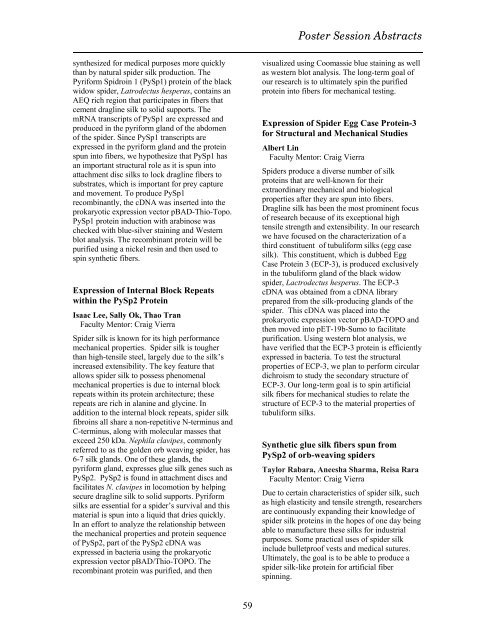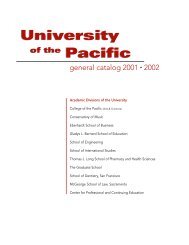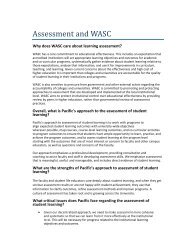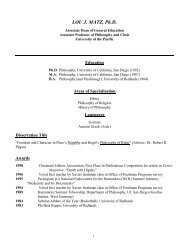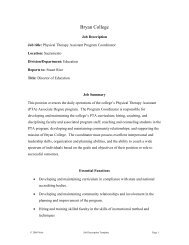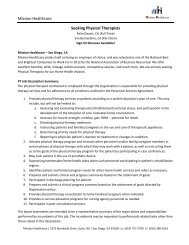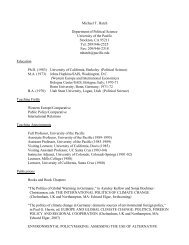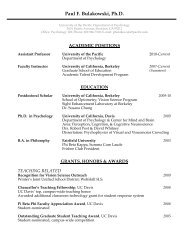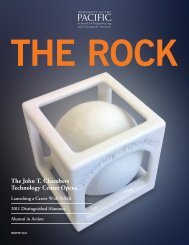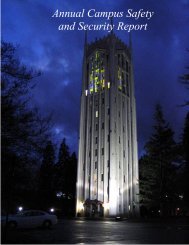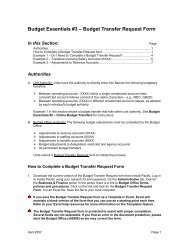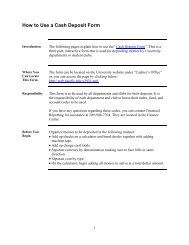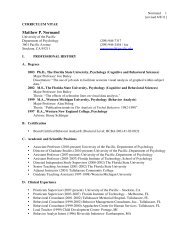purcc 2012 - University of the Pacific
purcc 2012 - University of the Pacific
purcc 2012 - University of the Pacific
Create successful ePaper yourself
Turn your PDF publications into a flip-book with our unique Google optimized e-Paper software.
Poster Session Abstracts<br />
syn<strong>the</strong>sized for medical purposes more quickly<br />
than by natural spider silk production. The<br />
Pyriform Spidroin 1 (PySp1) protein <strong>of</strong> <strong>the</strong> black<br />
widow spider, Latrodectus hesperus, contains an<br />
AEQ rich region that participates in fibers that<br />
cement dragline silk to solid supports. The<br />
mRNA transcripts <strong>of</strong> PySp1 are expressed and<br />
produced in <strong>the</strong> pyriform gland <strong>of</strong> <strong>the</strong> abdomen<br />
<strong>of</strong> <strong>the</strong> spider. Since PySp1 transcripts are<br />
expressed in <strong>the</strong> pyriform gland and <strong>the</strong> protein<br />
spun into fibers, we hypo<strong>the</strong>size that PySp1 has<br />
an important structural role as it is spun into<br />
attachment disc silks to lock dragline fibers to<br />
substrates, which is important for prey capture<br />
and movement. To produce PySp1<br />
recombinantly, <strong>the</strong> cDNA was inserted into <strong>the</strong><br />
prokaryotic expression vector pBAD-Thio-Topo.<br />
PySp1 protein induction with arabinose was<br />
checked with blue-silver staining and Western<br />
blot analysis. The recombinant protein will be<br />
purified using a nickel resin and <strong>the</strong>n used to<br />
spin syn<strong>the</strong>tic fibers.<br />
Expression <strong>of</strong> Internal Block Repeats<br />
within <strong>the</strong> PySp2 Protein<br />
Isaac Lee, Sally Ok, Thao Tran<br />
Faculty Mentor: Craig Vierra<br />
Spider silk is known for its high performance<br />
mechanical properties. Spider silk is tougher<br />
than high-tensile steel, largely due to <strong>the</strong> silk’s<br />
increased extensibility. The key feature that<br />
allows spider silk to possess phenomenal<br />
mechanical properties is due to internal block<br />
repeats within its protein architecture; <strong>the</strong>se<br />
repeats are rich in alanine and glycine. In<br />
addition to <strong>the</strong> internal block repeats, spider silk<br />
fibroins all share a non-repetitive N-terminus and<br />
C-terminus, along with molecular masses that<br />
exceed 250 kDa. Nephila clavipes, commonly<br />
referred to as <strong>the</strong> golden orb weaving spider, has<br />
6-7 silk glands. One <strong>of</strong> <strong>the</strong>se glands, <strong>the</strong><br />
pyriform gland, expresses glue silk genes such as<br />
PySp2. PySp2 is found in attachment discs and<br />
facilitates N. clavipes in locomotion by helping<br />
secure dragline silk to solid supports. Pyriform<br />
silks are essential for a spider’s survival and this<br />
material is spun into a liquid that dries quickly.<br />
In an effort to analyze <strong>the</strong> relationship between<br />
<strong>the</strong> mechanical properties and protein sequence<br />
<strong>of</strong> PySp2, part <strong>of</strong> <strong>the</strong> PySp2 cDNA was<br />
expressed in bacteria using <strong>the</strong> prokaryotic<br />
expression vector pBAD/Thio-TOPO. The<br />
recombinant protein was purified, and <strong>the</strong>n<br />
visualized using Coomassie blue staining as well<br />
as western blot analysis. The long-term goal <strong>of</strong><br />
our research is to ultimately spin <strong>the</strong> purified<br />
protein into fibers for mechanical testing.<br />
Expression <strong>of</strong> Spider Egg Case Protein-3<br />
for Structural and Mechanical Studies<br />
Albert Lin<br />
Faculty Mentor: Craig Vierra<br />
Spiders produce a diverse number <strong>of</strong> silk<br />
proteins that are well-known for <strong>the</strong>ir<br />
extraordinary mechanical and biological<br />
properties after <strong>the</strong>y are spun into fibers.<br />
Dragline silk has been <strong>the</strong> most prominent focus<br />
<strong>of</strong> research because <strong>of</strong> its exceptional high<br />
tensile strength and extensibility. In our research<br />
we have focused on <strong>the</strong> characterization <strong>of</strong> a<br />
third constituent <strong>of</strong> tubuliform silks (egg case<br />
silk). This constituent, which is dubbed Egg<br />
Case Protein 3 (ECP-3), is produced exclusively<br />
in <strong>the</strong> tubuliform gland <strong>of</strong> <strong>the</strong> black widow<br />
spider, Lactrodectus hesperus. The ECP-3<br />
cDNA was obtained from a cDNA library<br />
prepared from <strong>the</strong> silk-producing glands <strong>of</strong> <strong>the</strong><br />
spider. This cDNA was placed into <strong>the</strong><br />
prokaryotic expression vector pBAD-TOPO and<br />
<strong>the</strong>n moved into pET-19b-Sumo to facilitate<br />
purification. Using western blot analysis, we<br />
have verified that <strong>the</strong> ECP-3 protein is efficiently<br />
expressed in bacteria. To test <strong>the</strong> structural<br />
properties <strong>of</strong> ECP-3, we plan to perform circular<br />
dichroism to study <strong>the</strong> secondary structure <strong>of</strong><br />
ECP-3. Our long-term goal is to spin artificial<br />
silk fibers for mechanical studies to relate <strong>the</strong><br />
structure <strong>of</strong> ECP-3 to <strong>the</strong> material properties <strong>of</strong><br />
tubuliform silks.<br />
Syn<strong>the</strong>tic glue silk fibers spun from<br />
PySp2 <strong>of</strong> orb-weaving spiders<br />
Taylor Rabara, Aneesha Sharma, Reisa Rara<br />
Faculty Mentor: Craig Vierra<br />
Due to certain characteristics <strong>of</strong> spider silk, such<br />
as high elasticity and tensile strength, researchers<br />
are continuously expanding <strong>the</strong>ir knowledge <strong>of</strong><br />
spider silk proteins in <strong>the</strong> hopes <strong>of</strong> one day being<br />
able to manufacture <strong>the</strong>se silks for industrial<br />
purposes. Some practical uses <strong>of</strong> spider silk<br />
include bulletpro<strong>of</strong> vests and medical sutures.<br />
Ultimately, <strong>the</strong> goal is to be able to produce a<br />
spider silk-like protein for artificial fiber<br />
spinning.<br />
59


